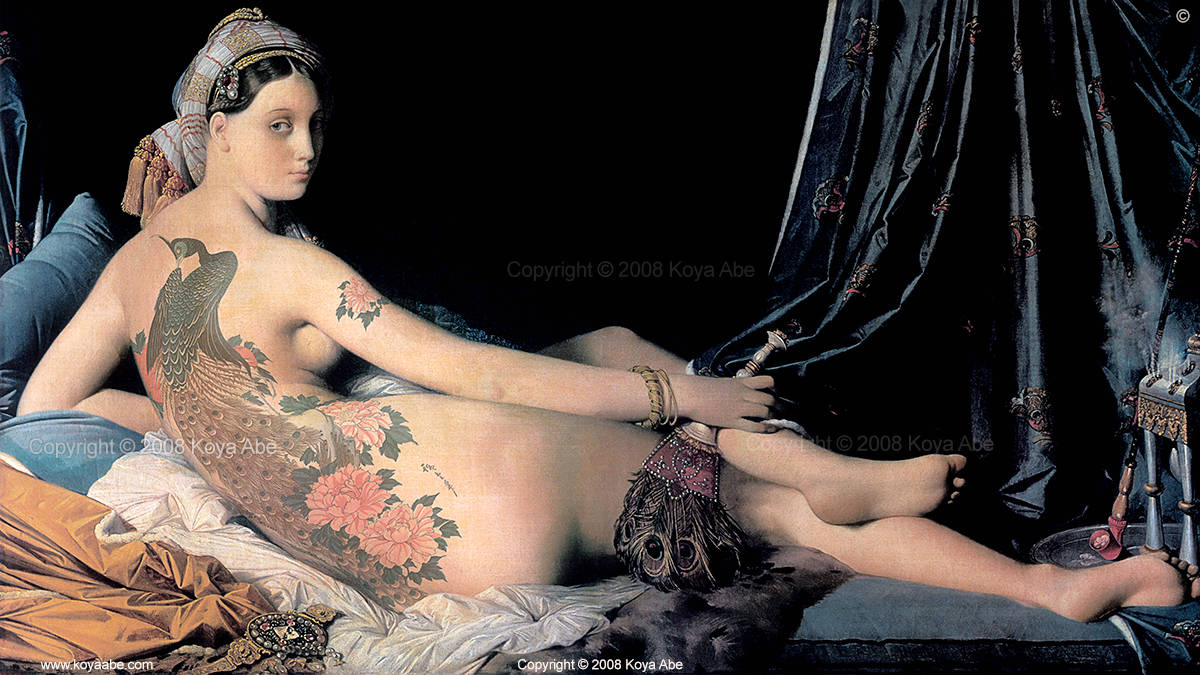Irezumi, the Japanese tattoo, is an art form that represents commitment, dedication and physicality. Digital media is an art form that represents transformation, flexibility and emptiness. Irezumi tattoo is also a traditional form of art whereas digital media is an emerging form of art. In my perspective, irezumi is ultimately loyalty and digital technology is deception. I became aware of these characteristic qualities initially, but then I realized that there are cultural, social and historical correlations between irezumi and digital media as well.
In considering Japanese art forms and history, I believe it is important to recognize that an artistic triangle exists between ukiyoe (woodblock prints), kabuki (opera) and irezumi (tattoo). These three traditional Japanese art forms are historically distinct, but yet they have a close relationship, and as a group they have influenced Japanese art and aesthetics over time. In particular, irezumi and ukiyoe are mutually dependent, like two sides of the same coin. Or more precisely, they are light and shadow, where ukiyoe is the public face of the art form and irezumi is its darker, more hidden side. Light and shadow are bound together–but yet they are not equal in status; darkness is perceived of as a lesser value than brightness. This inter-dependent state of inequality between irezumi and ukiyoe can exist in other relationships, and application of this dynamic is one of the key concepts examined in this project.
Historically, an irezumi artist was called a hori-shi in Japanese, which literally translated means “carving master-artist.” During the early period of the art form, many hori-shi began their careers, or had dual vocations as ukiyoe carving artists. This is significant in the history of Japanese art and it also represents a symbolic aspect of the relationship among the traditional art forms. (As a reference, the preferred and formal name for irezumi tattoo art is horimono, which means “carving work.”) This parallel development of ukiyoe and irezumi tattoo art is quite unique and to my knowledge, there are not any equivalent examples in the history of western art.
When the historical and social development of irezumi is examined, there is an interesting comparison with western art history. Historically, western tattoo art has no direct interaction with fine art. Traditional western fine art was not inclusive of tattoo art, or at the least it did not embrace tattoo’s aesthetic sensibilities, which illustrates the assumption that western tattooing and western fine art had different tracks of development. This observation also points again to an important aspect of the relationship between irezumi and ukiyoe. That is, not only do these traditional art forms share an aesthetic sense and style, but many masterpieces of ukiyoe have the characteristics of irezumi work, and vice versa. This must represent a mutual respect between practitioners of both art forms. Ultimately this relationship reveals the historical, social and artistic context of tattoo art in Japan. In contrast, eminent western artists did not historically represent tattoos in artwork as Japanese artist have, which is likely the result of the traditional separation of these art forms in western society. Nor does western painting share a mutual aesthetic with (western) tattoo art. In my view, this is a remarkable cultural distinction between the histories and development processes of Japanese and western art, a subject that should be worthy of examination.
In my view, one of the most important characteristics of traditional Japanese art is that it has not engaged in exclusivity as western art has historically. The open and democratic character of ukiyoe, kabuki and irezumi is demonstrated by its intended consumption by the mass populace in traditional Japanese society. These contrasting objectives of Japanese and western art reflect two significantly different approaches that have resulted in a distinctive character and history for the art of each culture. Interestingly, this contrast reveals a cultural and social twist. Despite the feudalistic social structure of the time, traditional Japanese society approached art in a democratic manner. On the other hand, western society approached art in a feudalistic and classist way for a long period of time and, in some ways, still continues on the same course. This is ironic considering that the concept of democracy began in and has been developed in the west. Yet, this same social construction did not develop in western art for some time.
After considering all of the conceptual parallels here, I began to realize that the act of tattooing western art icons signifies the tattooing of western art history as a whole. The act of tattooing western art offers these historic works an opportunity to depart from the mainstream and become part of the shadow history of art. This means that if we perceive western art as the illuminated face of the history of art, then we can see that Japanese art may be a shadow side of art history. My offering of a Japanese tattoo for western art essentially provides the opportunity for the art to be perceived from the shadow position; from the Japanese history perspective. The result of this practice is an examination of the dynamics between western art and Japanese/Eastern art. And ultimately, this relationship demonstrates the cultural power balances between them at the present time, in the form of light and shadow.
